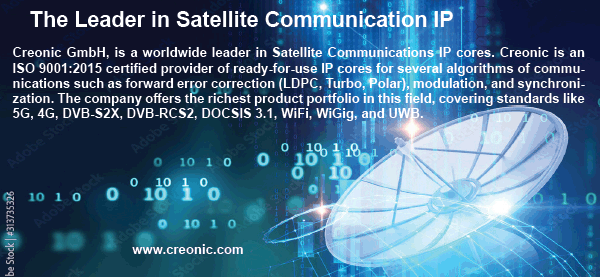IP Cores are a rarely talked about, essential part of modern communications infrastructure. IP in this case has nothing to do with internet protocol and everything to do with Intellectual Property. In simple terms, an IP Core is a predesigned sub-circuit that will be integrated into the complete product.
It is, however, a very complex block of electronic circuits. For most companies it is more efficient to purchase this from a third party for integration into its own integrated circuits (IC) than to design it themselves. This is because an IP core will do some of the basic functions that are common to all systems. In the case of satellite communications, for example, every modem, regardless of the manufacturer or model, provides the communication link between ground equipment and the satellite. It is therefore both cost and time efficient, to either use something that is totally or largely off-the-shelf (OTS) to do this. Or, if something really specialized is needed, to use the expertise of a company that specializes in this part of system to provide a customized core.
IP cores can be totally off-the-shelf (OTS) standardized products that are common to many products, GPS chips in mobile phones for example, or customized to the needs of one customer. Acquiring the IP core from a third party, not only shortens the design cycle, it also improves the success rate of a new design, as all, or large parts of the design have already been tried and tested.
IP cores will be incorporated into a field programmable gate array (FPGA) or into an application specific integrated circuit (ASIC) for the product. As the name implies FPGAs can be modified, making them very suitable for demonstration systems. ASICs on the other hand are customized for a particular application and are better suited for large volume production runs, as the initial cost is higher than that of a FPGA. ASICs are also generally more efficient than FPGAs.
IP Core Categories
IP cores can be classified into three categories: hard, firm or soft. Hard cores, are, as the name suggests, a physical product into which a fixed IP design is incorporated. Firm (or semi-hard) cores are also a physical product, but these can be tailored or configured to suit multiple applications. Soft cores exist as code which is licensed to the buyer and may also be customized. Companies that only supply soft cores are known as Fabless companies.
Creonic is one such Fabless company. Based in Kaiserslautern in Germany, the company is only ten years old and already boasts a very![]() impressive list of clients in the satellite industry. These include among others: NASA, Airbus Defence & Space, iDirect Government, Satixfy and WORK Microwave, as well as major launch providers, and other satellite manufacturers. Its IP cores can be found everywhere from large geostationary satellites (GEOs) to cubesats, as well as on the ground. Its IP cores are also used in deep space missions.
impressive list of clients in the satellite industry. These include among others: NASA, Airbus Defence & Space, iDirect Government, Satixfy and WORK Microwave, as well as major launch providers, and other satellite manufacturers. Its IP cores can be found everywhere from large geostationary satellites (GEOs) to cubesats, as well as on the ground. Its IP cores are also used in deep space missions.
The company was founded by Timo Lehnigk-Emden, PhD and Matthias Alles, PhD, in the basement of the Technical University of Kaiserslautern. It now has a staff of 20 and is in its third location. Creonic is experiencing a period of rapid growth, with revenue more than doubling in the last two years.
For the satellite industry Creonic’s focus is on IP cores for communication systems. These may be used in base stations, hubs and modems for backhaul and backbone, IP (internet protocol) trunking and VSAT modems, or, as already mentioned, may be incorporated into onboard payloads for satellites and probes.
Creonic licenses both off-the-shelf (OTS), i.e. standard IP cores, as well as customized cores modified to accommodate client requirements. Modifications may include adapting existing cores to meet individual requirements with regard to error correction, performance, throughput and flexibility. Similarly, the interfaces could be modified for simpler integration into a client’s system. And in some cases the core may be redesigned and/or extra features added, proprietary to a client. The company prides itself on “never saying no” to a client request.
Creonic, however is far more than simply a licensor of IP cores. It offers a complete communication design service for both ASIC and FGPA integration. Its engineers specialize in signal processing and therefore have the expertise to adapt standard components to meet every need so as to ensure that every system is both powerful and efficient.
Creonic still maintains very close ties with The Technical University at Kaiserslautern, a leading research institute in the field of communications, it is therefore in a position to also offer a consulting design service based on the very latest advances in communications and technology. It offers advice on digital signal processing (DSP) algorithms for both standards based systems (e.g. DVB) or proprietary systems. Similarly, advice is available on setting up demo systems using FPGAs and porting algorithms into FPGAs to reduce simulation times.
DVB-S2X
Creonic have a range of IP cores compliant with DVB-S2 and DVB-S2X. These include a DVB-S2X Modulator, a DVB-S2X Demodulator and a DVB-S2X low-density parity check/Bose-Chaudhuri-Hocquenghem (LDPC/BCH) Decoder.
The modulator, which is available for both ASIC and FPGAs (from Xilinx, Intel and Microchip) performs all the tasks of an inner transmitter. It expects basic block (BB) frames after mode adaption as input. It performs stream adaption, forward error correction (FEC) encoding, mapping, programming language (PL) framing and modulation. It supports:
• access control mechanism (ACM), constant control mechanism (CCM) and variable control mechanism (VCM) modes.
• Short and normal frames (16,200 bits and 64,800 bits)
• Quadra-phase shift keying (QPSK) to 256-APSK (amplitude and phase shift keying)
• Very low signal-to-noise (VLSNR) modes, (optional)
There are two versions, the M100 which offers a symbol rate of up to 200 mega-symbols for all modes, and the M400 which offers a symbol rate of up to 400 mega-symbols for all modes.
The demodulator, which is also available for both ASIC and FPGAs (from Xilinx and Intel) performs all the tasks of an inner receiver. It expects quantized complex baseband samples from an analog-digital converter (ADC) and it recovers timing, frequency and phase of the complex mapped symbols. In addition it handles physical layer (PL) frame recovery and de-framing. Its output fits the Creonic DVB-S2X FEC IP core that implements LDPC and BCH code. It supports:
• ACM, CCM and VCM modes.
• Short and long blocks (16,200 bits and 64,000 bits).
• QPSK and 256-APSK.
• VLSNR
The output is a complex FECframe (XFECFRAME) for further processing by the Creonic FEC decoder
The decoder – also available for ASIC and FPGAs (Xilinx and Intel) is a silicon-proven, scalable solution allowing for symbol rates of up to 100 mega-symbols on FPGAs. It has been validated against 3rd party DVB-S2X modulators. It supports:
• Decoding of BB frames.
• ACM, CCM and VCM modes
• SNR from -9.6 to 19.8dB
• Short, medium and normal frames (16,200, 32,400 and 64,800 bits).
• Binary phase shift keying (BPSK), QPSK, 8-PSK, 16-APSK, 32-APSK, 64-APSK, 128-APSK AND 256-APSK.
Kevin Christoffers, Creonic’s Sales Manager attributes the company’s rapid growth and success to its attention to detail, phenomenal customer service and high levels of transparency and flexibility, as well as having a well-educated staff with close ties to major research institutes. All of this is appreciated by Creonic’s customers as can be seen from these accolades: “We really appreciate Creonic’s high quality of code and documentation and your excellent support. We are looking forward to working with you on future projects!” And “On behalf of the Semihalf team, I would like to thank you for your successful cooperation. Our mutual customer is very satisfied by the end result, they are now able to run their BLER simulation in minutes instead of weeks in Matlab.”
Every customer is unique and has different needs and priorities, nevertheless there are some things that every customer wants from its IP Core supplier. These include: a great track record, blue chip customers, commitment to security, technical expertise, ability to develop customized solutions, choice of licenses and of course great customer service.
With NASA, Airbus Defence and Space and iDirect Government amongst its customers, Creonic clearly demonstrates that it meets the first three criteria. Its close association with leading technical universities and highly qualified staff are the key to its unique technical expertise and ability to tailor the solution to meet the client’s requirements. Customers can choose from several different license types, including a source code license, which permits the customer to ask Creonic to modify and customize the firmware. All of the licenses are for the duration of the product life.
The final demonstration of customer satisfaction comes from the Senior Procurement Administrator for a California based aerospace company: “Kevin, you are a kind and wonderful person…anyone that was good enough to put up with all the (as we say) “BS”…that we added to make this happen is the absolute BEST!!!”
When shopping for an IP core provider, you need to look out for key parameters such as technical expertise, commitment to security, proven track record, customer service, etc. Creonic checks all the necessary boxes.
For more information on Creonic go to: www.creonic.com
------------------------------
 Elisabeth Tweedie has over 20 years experience at the cutting edge of new communications entertainment technologies. She is the founder and President of Definitive Direction (www.definitivedirection.com), a consultancy that focuses on researching and evaluating the long-term potential for new ventures, initiating their development, and identifying and developing appropriate alliances. During her 10 years at Hughes Electronics, she worked on every acquisition and new business that the company considered during her time there. She can be reached at etweedie@definitivedirection.com.
Elisabeth Tweedie has over 20 years experience at the cutting edge of new communications entertainment technologies. She is the founder and President of Definitive Direction (www.definitivedirection.com), a consultancy that focuses on researching and evaluating the long-term potential for new ventures, initiating their development, and identifying and developing appropriate alliances. During her 10 years at Hughes Electronics, she worked on every acquisition and new business that the company considered during her time there. She can be reached at etweedie@definitivedirection.com.






